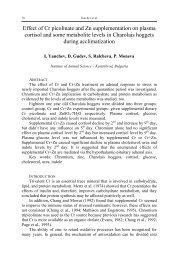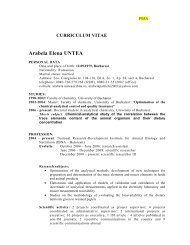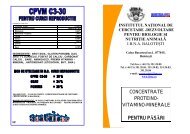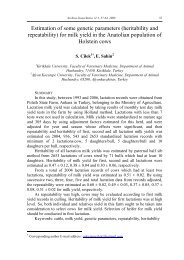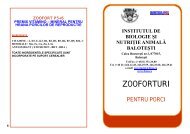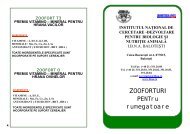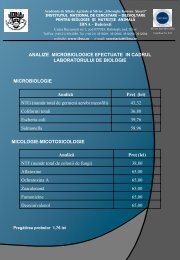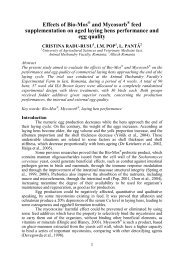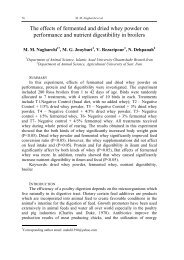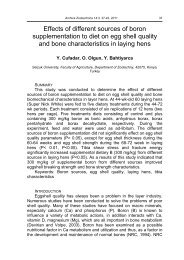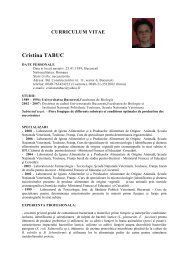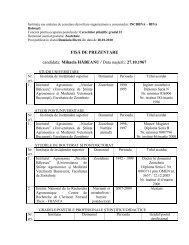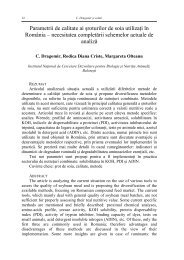( ) ( ) [ ] ( ) ( ) ( ) ( ) [ ]n ( ) ( ) [ ]n
( ) ( ) [ ] ( ) ( ) ( ) ( ) [ ]n ( ) ( ) [ ]n
( ) ( ) [ ] ( ) ( ) ( ) ( ) [ ]n ( ) ( ) [ ]n
You also want an ePaper? Increase the reach of your titles
YUMPU automatically turns print PDFs into web optimized ePapers that Google loves.
(5) g ( x,<br />
y,<br />
u,<br />
v)<br />
= a( x) f ( y,<br />
u) + C( y,<br />
u,<br />
v)<br />
a<br />
( x)<br />
=<br />
x<br />
β<br />
β<br />
2<br />
4<br />
β β 1<br />
+ β<br />
3<br />
+<br />
x −<br />
5<br />
C (y,u,v) = δ1V1<br />
−δ<br />
2u<br />
−δ<br />
3<br />
y<br />
⎛ θ<br />
4<br />
V1(x,y,u) =<br />
1u 2<br />
y<br />
3<br />
f ( y,<br />
u)<br />
5<br />
x ⎟ ⎞<br />
θ + θ +<br />
⎜θ<br />
+<br />
⎝ θ − ⎠<br />
where A: α1... α<br />
6;<br />
β1...<br />
β<br />
5;<br />
δ1...<br />
δ<br />
4;<br />
θ1...<br />
θ<br />
5;a,<br />
b are given constants.<br />
The experimental data show that the state variables x, y must fall within preset limits.<br />
(6)<br />
y ∈<br />
x ∈<br />
[ y1,<br />
y2<br />
] = [ 30,110]<br />
[ d ( y) , d ( y)<br />
]<br />
1<br />
2<br />
Other limits can also be set but the constants used to define the functions from (5) may<br />
change.<br />
As it can be observed, the functions defining system (4) are generally quite<br />
complicated but the problem is now clearly formulated. It may also be noticed that (4)<br />
is a command system whose data are non-differentiable (but are Liepschtesian), which<br />
requires methods of the non-differentiable analysis that developed a lot recently.<br />
Furthermore, the functions from (5) that define system (4) have a structure of stratified<br />
functions and therefore the methods from (3) might apply.<br />
Each of the optimisation problems presented above consists in the minimisation of a<br />
cost functional defined as follows:<br />
The problem of the minimum period is formulated as follows:<br />
Given yF ∈ (y1, y2], for any<br />
(x0,y0) ∈X0 = {( x, y) / y ∈ [ y1 , y2<br />
); x ∈[ d1( y) , d<br />
2<br />
( y)<br />
] } determine ~ t > F<br />
0 and<br />
2<br />
( u~<br />
(.), v ~ (.) ):[ 0, t<br />
F<br />
] → IR +<br />
so that the system of differential equations from(4)<br />
admits a solution ( ~ x (.),<br />
~ y (.))<br />
defined on [0,tF] that verifies the restrictions from (4) and<br />
~ x t , ~ y t ∈ X ∀t<br />
∈ 0,<br />
~<br />
t , y<br />
~<br />
t = y<br />
(7) ( ( ) ( )) 0<br />
[<br />
F<br />
] (<br />
F<br />
)<br />
F<br />
and which minimises the functional; C (u(.), v(.)) defined by:<br />
t<br />
(8) C (u(.), v(.)) = tF =<br />
∫ F<br />
dt<br />
0<br />
in the class of all the admitted commands having these properties.<br />
In order to calculate the maximal amount of protein produced during a given period,<br />
T>0 one must minimise functional C (.,.) defined by:<br />
(9) C (u(.),v(.)) = -x(T) for each:


![( ) ( ) [ ] ( ) ( ) ( ) ( ) [ ]n ( ) ( ) [ ]n](https://img.yumpu.com/22443310/3/500x640/-n-n.jpg)
